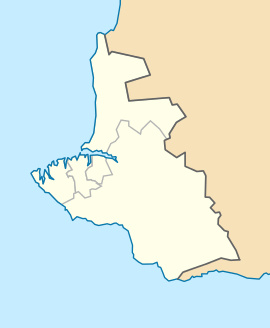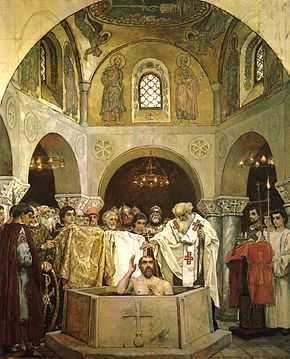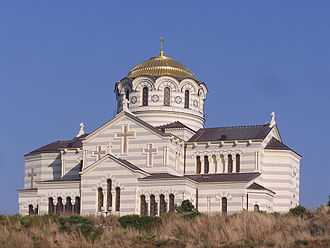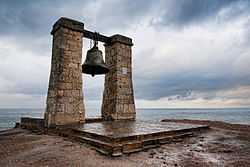Chersonesus
| Chersonesus | |
|---|---|
|
Χερσόνησος Херсонес | |
|
St. Vladimir's Cathedral overlooks the extensive excavations of Chersonesus. | |
 Shown within Sevastopol | |
| Alternate name | Chersonese, Chersonesos, Cherson |
| Location | Gagarin Raion, Sevastopol |
| Region | Taurica |
| Coordinates | 44°36′42″N 33°29′36″E / 44.61167°N 33.49333°ECoordinates: 44°36′42″N 33°29′36″E / 44.61167°N 33.49333°E |
| Type | Settlement |
| Part of | National Preserve "Khersones Tavriysky" |
| Area | 30 ha (74 acres) |
| History | |
| Builder | Settlers from Heraclea Pontica |
| Founded | 6th century BC |
| Abandoned | Around 1400 AD |
| Periods | Classical Greece to Late Middle Ages |
| Cultures | Greek, Roman, Hunnic, Byzantine |
| Site notes | |
| Excavation dates | 1827 |
| Management | The National Preserve of Tauric Chersonesos |
| Website |
www |
| Official name | Ancient City of Tauric Chersonese and its Chora |
| Type | Cultural |
| Criteria | ii, v |
| Designated | 2013 (137th session) |
| Reference no. | 1411 |
| Region | Europe and North America |
Chersonesus (Ancient Greek: Χερσόνησος Chersonēsos; Latin: Chersonesus; modern Ukrainian: Херсонес, Khersones, Russian: Херсонес, Khersones; also rendered as Chersonese, Chersonesos), in medieval Greek contracted to Cherson (Χερσών; Old East Slavic: Корсунь, Korsun) is an ancient Greek colony founded approximately 2,500 years ago in the southwestern part of the Crimean Peninsula. The colony was established in the 6th century BC by settlers from Heraclea Pontica.
The ancient city is located on the shore of the Black Sea at the outskirts of Sevastopol on the Crimean Peninsula, where it is referred to as Khersones. It has been nicknamed the "Ukrainian Pompeii" and "Russian Troy". The site is now part of the National Historical-Archeological Museum-Zapovednik of the Ukrainian Khersones Tavriysky. The name "Chersonesos" in Greek means "peninsula", and aptly describes the site on which the colony was established. It should not be confused with the Tauric Chersonese, the name often applied to the whole of the southern Crimea.
During much of the classical period Chersonesus was a democracy ruled by a group of elected archons and a council called the Demiurgi. As time passed the government grew more oligarchic, with power concentrated in the hands of the archons. A form of oath sworn by all the citizens since the 3rd century BC has survived to the present day. In 2013, Chersonesus was listed as a World Heritage Site.
History
Antiquity

In the late 2nd century BC Chersonesus became a dependency of the Bosporan Kingdom. It was subject to Rome from the middle of the 1st century BC until the 370s AD, when it was captured by the Huns.
Byzantine Era
It became a Byzantine possession during the Early Middle Ages and withstood a siege by the Göktürks in 581. Byzantine rule was slight: there was a small imperial garrison more for the town's protection than for its control. It was useful to Byzantium in two ways: as an observation point to watch the barbarian tribes, and its isolation made it a popular place of exile for those who angered the Roman and later Byzantine governments. Among its more famous "inmates" were Pope Clement I and Pope Martin I, and the deposed Byzantine Emperor Justinian II. According to Theophanes the Confessor and others, Chersonesus was the residence of a Khazar governor (tudun) in the late 7th century.

In 833 Emperor Theophilus sent the nobleman Petronas Kamateros, who had recently overseen the construction of the Khazar fortress of Sarkel, to take direct control over the city and its environs, establishing the theme of Klimata/Cherson. It remained in Byzantine hands until the 980s, when it reportedly fell to Kiev. Vladimir the Great agreed to evacuate the fortress only if Basil II's sister Anna Porphyrogeneta would be given him in marriage. The demand caused a scandal in Constantinople, as imperial princesses had never been married to non-Greeks before. As a pre-condition for the marriage settlement, Vladimir was baptized here in 988, thus paving the way to the Baptism of Kievan Rus'. Thereafter Korsun' was evacuated.
Since this campaign is not recorded in Greek sources, historians have suggested that this account actually refers to the events of the Rus'-Byzantine War (1043) and to a different Vladimir. In fact, most valuables looted by the Slavs in Korsun' made their way to Novgorod (perhaps by way of Ioakim Korsunianin, the first Novgorodian bishop, as his surname indicates ties to Korsun), where they were preserved in the Cathedral of Holy Wisdom until the 20th century. One of the most interesting items from this "Korsun Treasure" is the copper Korsun Gate, supposedly captured by the Novgorodians in Korsun' and now part of the St. Sophia Cathedral.
After the Fourth Crusade Chersonesus became dependent on the Empire of Trebizond, and then fell under Genoese control in the early 13th century. In 1299, the town was sacked by the armies of Nogai Khan.
In 1333 a Latin Church diocese of Chersonnesus was established, but it appears that it had only bishop, a Dominican called Richard the Englishman.[1][2] [3] No longer a residential bishopric, Chersonnesus in Zechia is today listed by the Catholic Church as a titular see.[4] Chersonnesus had been a Greek episcopal see for centuries, elevated early to the rank of archbishopric, since it is mentioned as such in the Notitiae Episcopatuum; it disappeared after the Turkish conquest in 1475 and the destruction of the city.[5] In the late 19th century, St Vladimir's Cathedral (completed 1892) was built on a small hill overlooking the site; designed in Byzantine style, it was intended to commemorate the site of Vladimir's baptism.
Archaeological site



Chersonesus' ancient ruins are presently located in one of Sevastopol's suburbs. They were excavated by the Russian government, starting from 1827. They are today a popular tourist attraction, protected as an archaeological park.
The buildings mix influences of Greek, Roman and Byzantine culture. The defensive wall was approximately 3.5 kilometres (2.2 mi) long, 3.5 to 4 metres wide and 8 to 10 metres high with towers at a height of 10 to 12 metres. The walls enclosed an area of about 30 hectares (74 acres).[6] Buildings include a Roman amphitheatre and a Greek temple.
The surrounding land under the control of the city, the chora, consists of several square kilometres of ancient but now barren farmland, with remains of wine presses and defensive towers. According to archaeologists, the evidence suggests that the locals were paid to do the farm work instead of being enslaved.
The excavated tombstones hint at burial practices that were different from the Greek ones. Each stone marks the tomb of an individual, instead of the whole family and the decorations include only objects like sashes and weapons, instead of burial statues. Over half of the tombs archaeologists have found have bones of children. Burned remnants suggest that the city was plundered and destroyed.
In 2007, Chersonesus tied for fifth in the Seven Wonders of Ukraine poll.
On February 13, 2009, Ukrainian Defence Minister Yuriy Yekhanurov called on Russia's Black Sea naval fleet to move its automobile depot from the site to another place. The location of the Russian Black Sea naval fleet's automobile depot was one of the obstacles to the inclusion of the reserve on UNESCO's list of world heritage sites.[7]
The 1935 Basilica
The 1935 Basilica is the most famous basilica excavated in Chersonesus. The original name is unknown so "1935" refers to the year it was opened.[8] The basilica was probably built in the 6th century on the site of an earlier temple, assumed by historians to be a synagogue, itself replacing a small temple dating from the early days of Christianity.[9] The 1935 basilica is often used as an image representing Chersonesos. Its picture appears on one Ukrainian banknote.[8]
Museum contents
As well as the archaeological sites, the museum has around 200,000 smaller items from 5 AD to the 15th century, over 5,000 of which are currently exhibited. These include:[10]
- ancient texts, including the Oath of Chersonese citizens (3 AD), decrees in honour of Diophantus (2nd Century AD)
- a collection of coins
- a mosaic of black and white pebbles and coloured stones
- ancient ceramics
- architectural fragments, including ancient and medieval abacuses, reliefs, the remains of ancient murals
Current studies
The Institute of Classical Archaeology of the University of Texas at Austin and the local Archaeological Park has investigated the site since 1992. The Ukrainian government has included the site on its tentative World Heritage List. The site, however, is in danger of further urban encroachment and coastal erosion.
In 2013, Chersonesus was listed as a World Heritage Site."Ancient City of Tauric Chersonese and its Chora". UNESCO. as Ancient City of Tauric Chersonese and its Chora. During the 2014 Crimean crisis the Crimean peninsula was annexed by Russia, but UNESCO has maintained that it will continue to recognize Crimea and its heritage sites as belonging to Ukraine.[11]
Threats to Chersonesus
The encroachment of modern building in and around the ancient archaeological site, coupled with a lack of funding to prevent such development pressures, has left the site of Chersonesus firmly at risk.[12]
In an October 2010 report titled Saving Our Vanishing Heritage, Global Heritage Fund identified Chersonesus as one of 12 worldwide sites most "On the Verge" of irreparable loss and destruction, citing insufficient management and development pressures as primary causes.[13]
See also
- List of traditional Greek place names
- Odessa Numismatics Museum having on display coins of Chersonesus
- The bell of Chersonesus
References
- ↑ Konrad Eubel, Hierarchia Catholica Medii Aevi, vol. 1, p. 184
- ↑ Pius Bonifacius Gams, Series episcoporum Ecclesiae Catholicae, Leipzig 1931, p. 365
- ↑ J. Buchan Telfer, The Crimea and Transcaucasia (London 1876), vol. I, p. 52
- ↑ Annuario Pontificio 2013 (Libreria Editrice Vaticana 2013 ISBN 978-88-209-9070-1), p. 868
- ↑ Raymond Janin, v. 3. Chersonnèse, in Dictionnaire d'Histoire et de Géographie ecclésiastiques, vol. XII, Parigi 1953, coll. 636-638
- ↑ "City". National Preserve of Tauric Chersonesos. Retrieved 18 February 2013.
- ↑ "Yekhanurov Calls On Russia's Black Sea Naval Fleet To Move Its Automobile Depot From Khersones Tavriiskyi National Reserve". Ukrainian News Agency. February 13, 2009.
- ↑ 8.0 8.1 "Ancient Chersoneses in Crimea: Dilettante travel". Retrieved 1 April 2012.
- ↑ Valentine Gatash (2 June 2007). "Базиліка зникне в морі? ("Will the Basilica disappear into the sea?")" (in Ukrainian). Retrieved 1 April 2012.
- ↑ "Chersonesus Taurica". Restgeo.com. Retrieved April 1, 2012.
- ↑ http://www.unian.net/politics/906559-yunesko-i-vpred-budet-schitat-kryim-territoriey-ukrainyi.html
- ↑ "Managing the Archaeological Heritage at the National Preserve of Tauric Chersonesos: Problems and Perspectives". Ukrainian Museum. October 2006.
- ↑ "GHF". Global Heritage Fund. Retrieved 2012-08-31.
References and further reading
- Anokhin, V.A. The Coinage of Chersonesus: IV century B.C.–XII century A.D.. Oxford : British Archaeological Reports, 1980 (paperback, ISBN 0-86054-074-X).
- Carter, Joseph Coleman; Crawford, Melba; Lehman, Paul; Nikolaenko, Galina; Trelogan, Jessica. "The Chora of Chersonesos in Crimea, Ukraine", American Journal of Archaeology, Vol. 104, No. 4. (2000), pp. 707–741.
- Carter, Joseph Coleman; Mack, Glenn Randall. Crimean Chersonesos: City, Chora, Museum, and Environs. Austin, TX: David Brown Book Company, 2003 (paperback, ISBN 0-9708879-2-2).
- Kozelsky, Mara. "Ruins into Relics: The Monument to Saint Vladimir on the Excavations of Chersonesos, 1827–57", The Russian Review, Vol. 63, No. 4. (2004), pp. 655–672.
- Norwich, John Julius. Byzantium: The Early Centuries. New York: Alfred A. Knopf, 1989 (hardcover, ISBN 0-394-53778-5).
- Saprykin, S.Yu. Heracleia Pontica and Tauric Chersonesus before Roman domination: (VI–I centuries B.C.). Amsterdam: A.M. Hakkert, 1997 (ISBN 9025611095).
External links
| Wikimedia Commons has media related to Chersonesos Taurica. |
- University of Texas at Austin Institute of Classical Archaeology Chersonesos project
- Bulletin of the Odessa Numismatics Museum
- National Preserve of Tauric Chersonesos, Sevastopol
- Cherson on Regnal Chronologies
- Brief History of Antique Cities of Tauria and Their Coinage.
- Panorams of Chersonesos - (Russian)
- Photo of Chersonesos - (Russian)
- High resolution image of antique map of this region
- Explore Chersonesos with Google Earth on Global Heritage Network
- Notes and Materials from Archaeological Excavation
| ||||||||
| ||||||||||||||||||
| |||||||||||||||||||||||||||||

.svg.png)
